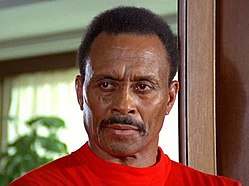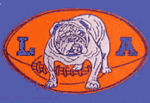After reaching a peak in 1945, the importance and popularity of the PCPFL declined rapidly in the post-World War years as the NFL's Los Angeles Rams and the All-America Football Conference’s Los Angeles Dons established a major league presence with games in the Coliseum. The resulting competition was devastating to the PCPFL. The league rapidly declined in 1946 and eventually folded in 1948. Prior to 1936, the history of professional football in California was not a hopeful one. While there were two major league Los Angeles teams in 1926. The Buccaneers of the NFL and the Los Angeles Wildcats were the first American Football League, both were actually traveling teams that only lasted one season. In 1934, four teams from the Los Angeles area and two from San Francisco formed another Pacific Coast League; when the two San Francisco teams withdrew from the league after the 1934 season, the four L.A. teams continued to compete in 1935 as the American Legion League. It folded after one season.

The league became the “home” of African American football stars including future NFL players Kenny Washington and Woody Strode of the Rams. The league even included HOF MLB player Jackie Robinson. The NFL had developed and enforced a color barrier in 1934 and extended until 1946 when the Rams signed Strode and Washington. The AAFL also signed HOF players Marion Motley and Bill Willis that same year (signed by the Cleveland Browns).

Pacific Coast Professional Football League (PCPFL), also known as the Pacific Coast Football League (PCFL) and Pacific Coast League (PCL) was a professional American football league based in California. It operated from 1940 through 1948. At the time the NFL had no teams on the west coast with Chicago and Green Bay being the farthest teams west. The Rams did eventually move to Los Angeles after leaving Cleveland following the 1945 season. The PCPFL was also the first professional football league to have a team located in Hawaii.

The Los Angeles Bulldogs were the most relevant or well-known team in the PCPFL. The Bulldogs played all the games in its inaugural season at Gilmore Stadium, playing local teams like the Salinas Packers and the Hollywood Stars, but also the Philadelphia Eagles (won, 10–7), Pittsburgh Pirates (won, 21–7), Chicago Cardinals (won, 13–10), Brooklyn Dodgers (tied, 13–13), Chicago Bears (lost, 7–0), and Green Bay Packers (lost, 49–0). In their six games against the NFL, the Bulldogs compiled a 3–2–1 record while having a 6–3–1 season overall. In the second AFL and in 1937 the Bulldogs were invited to replace the Rams in the fledgling league, and proceeded with the first perfect season in major league professional football: eight wins in AFL games, 18 wins including exhibition games, no losses, no ties. Not even the Miami Dolphins, who lost an exhibition game immediately prior to their 1972 season, can make that claim. The Bulldogs’ complete dominance of the league exacerbated the financial difficulties of the AFL to the point that the league was forced to fold after the end of the 1937 season. The Bulldogs won the 1939 league title and before the end of league play, had already given notice that they would be leaving at the end of the season to become a charter member of the Pacific Coast Professional Football League.

The PCPFL started its first season with 5 teams. The Los Angeles Bulldogs, Hollywood Bears, Oakland Giants, Phoenix Panthers, and San Diego Bombers. The Bulldogs won the first league title in 1940 with the Bears winning it the following year. From 1942-44 the Bombers won the title each year. The Bears would resurface as champions in 1945. The biggest impacts to the league in 1946 would be the result of changes the NFL made. One being removing the color barrier allowing some of the PCPFL stars to go to the NFL and the Rams moving to Los Angeles. The Rams moving to the Coliseum really negatively impacted attendance in the smaller stadiums that the Bulldogs and Hollywood Bears. Even in this time the PCPFL tried expanding in 1946 having 9 teams in two divisions with a playoff game between the two division champions. New teams include the Tacoma Indians, Sacramento Nuggets, and the Hawaiian Warriors. The San Jose Mustangs were sold and relocated to Utah, becoming the Salt Lake Seagulls. The Hawaiians played all their games at home, and generally in two-game sets to minimize travel expenses for the mainland opponents. With their own officiating crew, the Warriors had a perceived advantage as they consistently played in front of crowds of upward of 15,000 people where with other teams might only have 1,000 fans in attendance. The PCPFL, the Dixie League, and the American Association (which changed its name to the American Football League in 1946) entered into a working arrangement with the NFL, agreeing to being, in essence, a farm league. This arrangement meant no player participating in the farm leagues could play in the AAFC. The compact was formalized March 24, 1946, with the announcement of the formation of the Association of Professional Football Leagues. The season ended in controversy as the Northern Division title was determined by a game in which the San Francisco Clippers apparently defeated the Los Angeles Bulldogs by a score of 24-19 and claimed the top spot in the division. When Clippers owner Frank Ciraolo entered his team's locker room to participate in the victory celebration, he noticed that John Woudenberg, tackle for the San Francisco 49ers, was wearing a uniform that was assigned to the Clippers’ Courtney Thorell. After the discrepancy was reported to league officials, the game was declared a 1-0 forfeit to the Bulldogs. As a result, the Northern Division champions were the Tacoma Indians. The Bulldogs, with 11 players with NFL experience, defeated Tacoma in the league championship game, 38-7, on January 19, 1947. It was the last game of the Indians’ existence.
By the end of the 1947 season, Sacramento and Salt Lake dropped out of the league. With only three active franchises in the league it meant the league had a bleak future. An investigation led by league president J. Rufus Klawans revealed that members of the Hawaiian Warriors were placing bets on games in which they were participating. Abreu, Ray Scussell, Floyd “Scrap Iron” Rhea, and Jack Keenan were permanently banned from the league; another ten team members were “suspended indefinitely. So the league at the end of 1947 had banned players, three franchises, and many of its few stars leaving the league. As the PCPFL continues unraveling, the Hollywood Bears return to the fold after a second “leave of absence.” The revitalized Bears were under the watchful eye of former Bulldogs owner Jerry Corcoran as they re-entered the league as a traveling team. The Bulldogs, who used to sell out games at 18,000-seat Gilmore Stadium, had to move to Long Beach, California, after two years of failing to attract 1000 fans in their home games. The Warriors were the class of the league, averaging 30 points of offense per game despite losing over half of the 1947 squad. They had claimed at least tie for the league title with a 5-1 record, with the Bulldogs having two games left to play, one with the Bears and the other one with the Clippers in Long Beach's Veterans Memorial Stadium. The games were not played. The legendary Los Angeles Bulldogs (who were the Long Beach Bulldogs in 1948) had called it quits after drawing only 850 fans in the only PCPFL game in Long Beach; the league soon followed suit and folded.
Sources
https://www.pro-football-reference.com/
https://www.profootballarchives.com/index.html
https://americanfootballdatabase.fandom.com/wiki/Football_Wiki
https://www.gridiron-uniforms.com/GUD/controller/controller.php?action=main
https://www.profootballhof.com/hall-of-famers/
PCPFL: 1940–45 Archived July 26, 2011, at the Wayback Machine – Bob Gill, The Coffin Corner, Pro Football Researchers Association (1982)
The End of the PCPFL Archived November 27, 2010, at the Wayback Machine – Bob Gill, The Coffin Corner, Pro Football Researchers Association (1983)
The Bulldogs: L.A. Hits the Big Time Archived November 27, 2010, at the Wayback Machine – Bob Gill, Pro Football Researchers Association (1984)
Other Minor Leagues Archived November 27, 2010, at the Wayback Machine – a look at football's minor leagues before 1960, Bob Gill, The Coffin Corner, Pro Football Researchers Association (1989).
"THE COFFIN CORNER: Vol. 31, No. 1 (2009)" (PDF). THE COFFIN CORNER.
Other Minor Leagues Archived November 27, 2010, at the Wayback Machine – a look at football's minor leagues before 1960, Bob Gill, The Coffin Corner, Pro Football Researchers Association (1989)
California Dreamin': West Coast Pros in the 1930s Archived November 27, 2010, at the Wayback Machine – Bob Gill and Tod Maher, The Coffin Corner, Pro Football Researchers Association (1984)
"Salinas Packers; California Pro American Football 1936–1937". October 12, 2019.
"The Salinas Packers" (PDF).
"1938 Los Angeles Bulldogs".
"Professional Football Researchers Association- Pro Football History". www.footballresearch.com. Archived from the original on March 19, 2006. Retrieved January 12, 2022.
"The Salt Lake Seagulls" (PDF).
Tacoma Story Archived November 26, 2010, at the Wayback Machine – Bart Ripp, The Coffin Corner, Pro Football Researchers Association (2002)
The Salt Lake Seagulls Archived October 7, 2010, at the Wayback Machine – Mel Bashore, The Coffin Corner, Pro Football Researchers Association (1992)
The Salt Lake Seagulls Archived October 9, 2010, at the Wayback Machine – Mel Bashore, The Coffin Corner, Pro Football Researchers Association (1992)
"Flores blazes trail to HOF Doorstep".
Bob Gill, with Tod Maher. Outsiders II: Minor League And Independent Football, 1951–1985, p. vii. St. Johann Press, 2010. ISBN 1878282654
"PETALUMA FOOTBALL HISTORY: Football players led on the gridiron and in the community". September 7, 2016.
"Seahawks Give Up; Cancel Remaining Contests".
"September 6, 1957 Petaluma Argus-Courier from Petaluma, California". September 6, 1957.
"Hellcats Will Scrimmage This Afternoon At 3". The Fresno Bee. November 24, 1957. p. 35.
"Orange County Rhinos beat the NFL to local TV". Los Angeles Times. March 6, 2011.
"Orange County Rhinos Will Join New Loop". Independent. May 30, 1958. p. 19.
"The Tucson Sugar Skulls have joined the pantheon of amateur and professional sports team names in Tucson". March 2, 2019.
"Eracs suffer 7–3 loss to Anaheim Rhinos".
"Allen severs ties with Oxy football". cdnc.ucr.edu. Belvedere Citizen / Eastside Journal. March 12, 1980. Retrieved July 31, 2023.
"It's a Minor Thing" (PDF).
"Looking back after 30 years". August 17, 2004.
"1978–1981 Shreveport Steamer". May 6, 2018.
"NWFL Archives League Standings 1979–1986". Archived from the original on November 11, 1999.
"Pacific Northwest Football League 1980". December 24, 2019.
"Twin Cities Cougars". Fun While It Lasted. July 16, 2022.

No comments:
Post a Comment